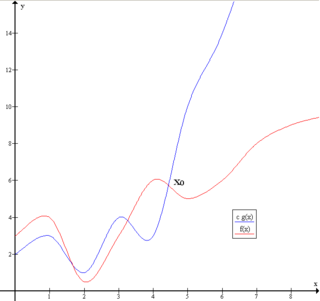In calculus, the chain rule is a formula that expresses the derivative of the composition of two differentiable functions f and g in terms of the derivatives of f and g. More precisely, if is the function such that for every x, then the chain rule is, in Lagrange's notation,

In mathematics, convolution is a mathematical operation on two functions that produces a third function. The term convolution refers to both the result function and to the process of computing it. It is defined as the integral of the product of the two functions after one is reflected about the y-axis and shifted. The integral is evaluated for all values of shift, producing the convolution function. The choice of which function is reflected and shifted before the integral does not change the integral result. Graphically, it expresses how the 'shape' of one function is modified by the other.

The tiger is the largest living cat species and a member of the genus Panthera native to Asia. It has a powerful, muscular body with a large head and paws, a long tail, and orange fur with black, mostly vertical stripes. It is traditionally classified into nine recent subspecies, though some recognise only two subspecies, mainland Asian tigers and island tigers of the Sunda Islands.

Big O notation is a mathematical notation that describes the limiting behavior of a function when the argument tends towards a particular value or infinity. Big O is a member of a family of notations invented by German mathematicians Paul Bachmann, Edmund Landau, and others, collectively called Bachmann–Landau notation or asymptotic notation. The letter O was chosen by Bachmann to stand for Ordnung, meaning the order of approximation.

In physics, engineering and mathematics, the Fourier transform (FT) is an integral transform that takes a function as input and outputs another function that describes the extent to which various frequencies are present in the original function. The output of the transform is a complex-valued function of frequency. The term Fourier transform refers to both this complex-valued function and the mathematical operation. When a distinction needs to be made the Fourier transform is sometimes called the frequency domain representation of the original function. The Fourier transform is analogous to decomposing the sound of a musical chord into the intensities of its constituent pitches.

The electrical resistance of an object is a measure of its opposition to the flow of electric current. Its reciprocal quantity is electrical conductance, measuring the ease with which an electric current passes. Electrical resistance shares some conceptual parallels with mechanical friction. The SI unit of electrical resistance is the ohm, while electrical conductance is measured in siemens (S).
The orbital period is the amount of time a given astronomical object takes to complete one orbit around another object. In astronomy, it usually applies to planets or asteroids orbiting the Sun, moons orbiting planets, exoplanets orbiting other stars, or binary stars. It may also refer to the time it takes a satellite orbiting a planet or moon to complete one orbit.

In chemistry, the molar mass of a chemical compound is defined as the ratio between the mass and the amount of substance of any sample of the compound. The molar mass is a bulk, not molecular, property of a substance. The molar mass is an average of many instances of the compound, which often vary in mass due to the presence of isotopes. Most commonly, the molar mass is computed from the standard atomic weights and is thus a terrestrial average and a function of the relative abundance of the isotopes of the constituent atoms on Earth. The molar mass is appropriate for converting between the mass of a substance and the amount of a substance for bulk quantities.

In thermodynamics, the Gibbs free energy is a thermodynamic potential that can be used to calculate the maximum amount of work, other than pressure-volume work, that may be performed by a thermodynamically closed system at constant temperature and pressure. It also provides a necessary condition for processes such as chemical reactions that may occur under these conditions. The Gibbs free energy is expressed as

The Joinvilleaceae are a family of flowering plants with a single genus including four species. The APG II system, of 2003 assigns it to the order Poales in the clade commelinids in the monocots. The family consists of one genus with four currently accepted species, distributed from the Malay Peninsula to the Caroline Islands and high islands in the Pacific Ocean. It is evolutionarily significant as a relictual group closely related to grasses. They closely resemble large grass plants, in both general appearance and microanatomy, but possess fleshy fruits.
Omiodes asaphombra, sometimes called the ʻohe hedyleptan moth, is a species of moth in the family Pyralidae endemic to Hawaiʻi. It was listed as possibly extinct by the United States Fish and Wildlife Service, and as extinct by the IUCN and the Hawaii Biological Survey.
Correbidia is a genus of moths in the subfamily Arctiinae. The genus was erected by George Hampson in 1898.

Joinvillea plicata is a flowering plant species, one of four in the genus Joinvillea. It is found in New Caledonia and is considered a common plant by the natives.

Copaxa is a genus of moths in the family Saturniidae first described by Francis Walker in 1855.
Correbidia terminalis is a moth in the subfamily Arctiinae. It was described by Francis Walker in 1856. It is found from Mexico through Central America and Cuba and Puerto Rico to South America.

Correbidia calopteridia is a moth of the subfamily Arctiinae. It was described by Arthur Gardiner Butler in 1878. It is found in Pará, Brazil.
Correbidia notata is a moth of the subfamily Arctiinae. It was described by Arthur Gardiner Butler in 1878. It is found in the Amazon region.
Correbidia costinotata is a moth of the subfamily Arctiinae. It was described by Schaus in 1911. It is found in Costa Rica.
Correbidia simonsi is a moth of the subfamily Arctiinae. It was described by Rothschild in 1912.










